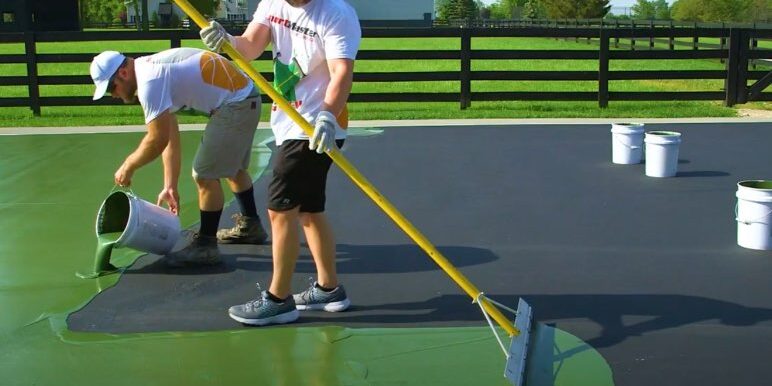Lasting Practices in Pickleball Court Construction You Need To Know
As the appeal of pickleball remains to climb, so as well does the demand for lasting methods in court construction. This strategy not only addresses ecological worries yet likewise enhances the long life and functionality of the courts. From picking environment-friendly products to carrying out efficient water drainage and energy-saving lighting options, there are numerous methods to consider. Yet, the influence of these methods extends much past the court itself. Comprehending exactly how each aspect adds to a more sustainable future invites additionally expedition into the elaborate equilibrium in between entertainment development and environmental stewardship.
Choosing Eco-Friendly Products
Picking eco-friendly materials is an essential step in the building of sustainable pickleball courts. The option of lasting materials not only reduces environmental effect however likewise improves the longevity and efficiency of the court. Trick materials include recycled rubber for the surface area, which supplies outstanding resilience and shock absorption while diverting waste from landfills.
Furthermore, using in your area sourced materials reduces transport emissions and supports local economic situations. Pickleball court construction. For instance, using native woods for fencing and seating can supply a sustainable visual while making certain resilience versus the aspects.
Including absorptive materials for court foundations can further contribute to sustainability by permitting for natural water drain and reducing overflow. These selections not only secure local ecological communities but likewise advertise much healthier play environments.
Reliable Water Drainage Solutions
While the selection of environment-friendly products is important, carrying out reliable drainage solutions is just as important for maintaining sustainable pickleball courts. Proper drain not just shields the court surface area from water damage but also lessens disintegration and overflow, promoting environmental stability.
Efficient drain systems can consist of absorptive paving, which enables water to infiltrate the ground rather than merging externally. This reduces the likelihood of standing water, which can lead to mold and mildew and various other upkeep concerns. In addition, including purposefully positioned water drainage networks and swales can direct excess water far from the court location, guaranteeing a dry having fun surface and avoiding dirt disintegration.
Utilizing native plant life in the landscaping around the courts can further improve water drainage by absorbing excess water and lowering overflow. These plants call for less watering and promote biodiversity, aligning with lasting techniques.
Moreover, it is essential to frequently preserve the drainage system to ensure its long-term performance. This consists of cleaning particles and monitoring for clogs. By focusing on reliable water drainage services, pickleball court fabricators can considerably add to the sustainability and longevity of the center, ultimately benefiting both gamers and the setting.
Energy-Efficient Lights Options
As the demand for pickleball continues to expand, incorporating energy-efficient lights alternatives into court style has actually ended up This Site being progressively essential for sustainability. Traditional lighting systems typically eat too much power, adding to greater functional prices and ecological influence. Embracing contemporary, energy-efficient technologies is essential for both new building and constructions and improvements.
LED (Light Emitting Diode) lights attracts attention as a top choice due to its durability and power financial savings (Pickleball court construction). Compared to standard illumination, LEDs use about 75% less power and can last as much as 25 times much longer, substantially decreasing upkeep expenses. In addition, the directional nature of LED lighting minimizes light air pollution, guaranteeing that lighting is concentrated on the court instead of bordering locations.

Lasting Surface Alternatives
Exploring sustainable surface area options for pickleball courts has obtained traction amongst contractors and gamers alike. The emphasis on eco-friendly products not just lines up with the expanding environmental understanding but likewise enhances the efficiency and resilience of the courts.
One preferred alternative is using recycled rubber, which can be sourced from made use of tires. This material supplies excellent shock absorption, minimizing the risk of injuries for players while promoting sustainability. In visit homepage addition, modular tiles made from recycled plastics provide an additional sensible option. These ceramic tiles are simple to change and install, and their flexibility enables for numerous court arrangements.
All-natural yard courts are additionally becoming a lasting option, promoting biodiversity and decreasing the heat island result. They require normal upkeep and water, which may not align with all sustainability objectives.

Water Conservation Methods

An additional reliable method includes the setup of rainwater harvesting systems. These systems save and accumulate rain for use in maintaining court surface areas and landscape design. This method not just saves safe and clean water however likewise reduces dependence on local sources.
Moreover, using drought-resistant landscaping around the courts is vital. Native plants call for less water and are much better adapted to local environment conditions, hence reducing total water usage. Additionally, making use of effective watering systems, such as drip irrigation, makes certain that water is provided straight to plant roots, decreasing evaporation and waste.
Verdict
Incorporating lasting practices in pickleball court building and construction considerably adds to environmental conservation and source efficiency. Making use of environmentally friendly materials, applying effective drain remedies, and adopting energy-efficient illumination alternatives can greatly decrease environmental influence. Furthermore, checking out sustainable surface area choices and employing water preservation strategies enhance the total sustainability of these leisure facilities - Pickleball court construction. By focusing on these techniques, the building and construction of pickleball courts can straighten with more comprehensive ecological objectives while advertising durability and capability within areas.
As the popularity of pickleball continues to increase, so also does the requirement for sustainable methods redirected here in court building.Selecting green materials is an important step in the construction of lasting pickleball courts. By prioritizing energy-efficient illumination options, pickleball court builders can add to a more sustainable future while fulfilling the requirements of gamers and stakeholders alike.Integrating lasting surface options not just enhances the performance of pickleball courts yet also paves the means for executing efficient water preservation techniques.Integrating lasting practices in pickleball court building substantially adds to environmental preservation and resource effectiveness.